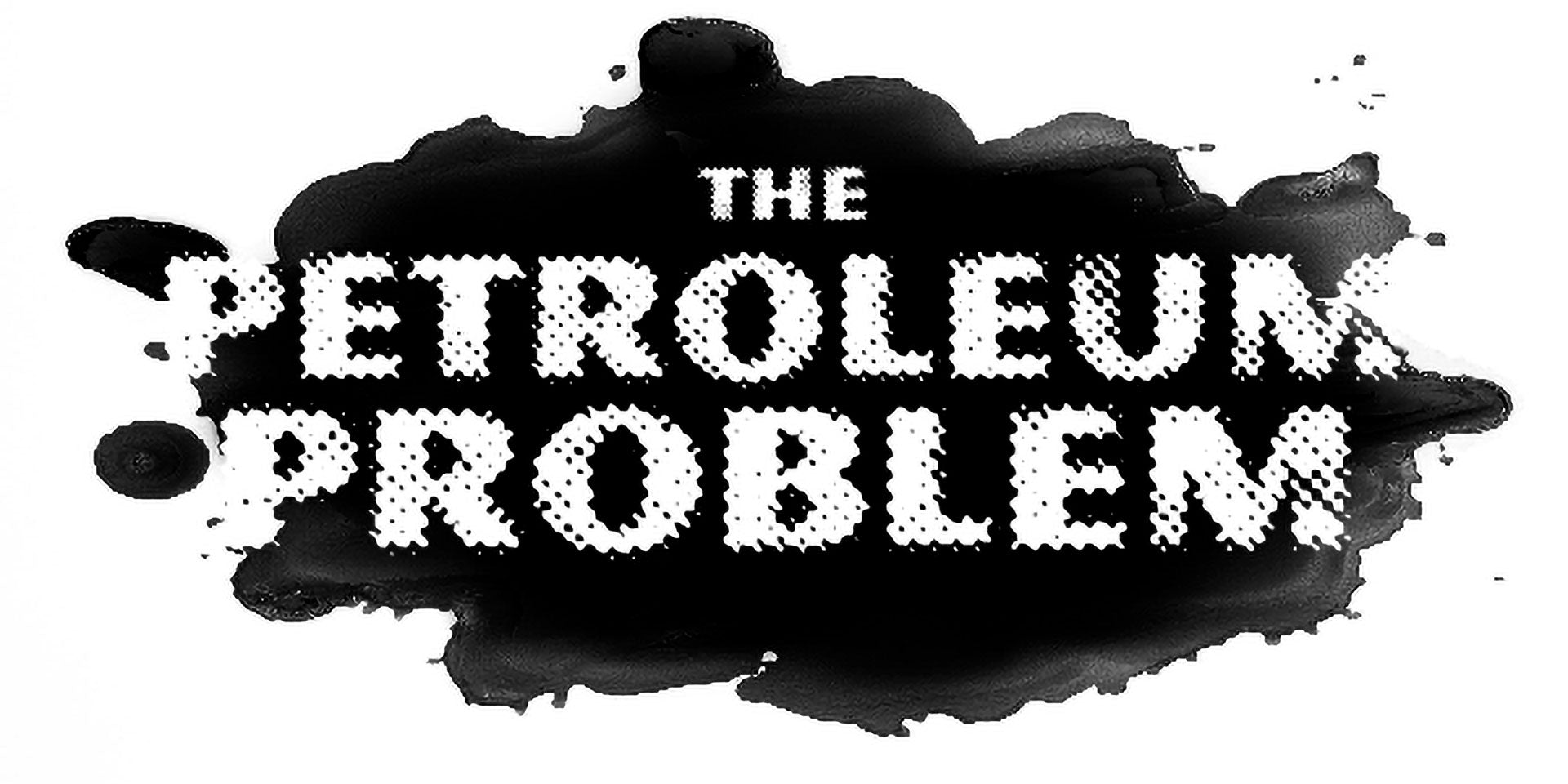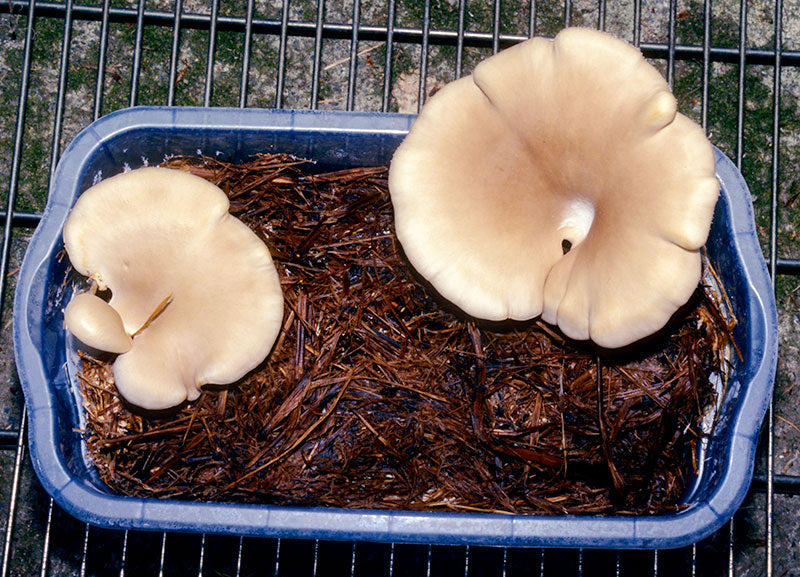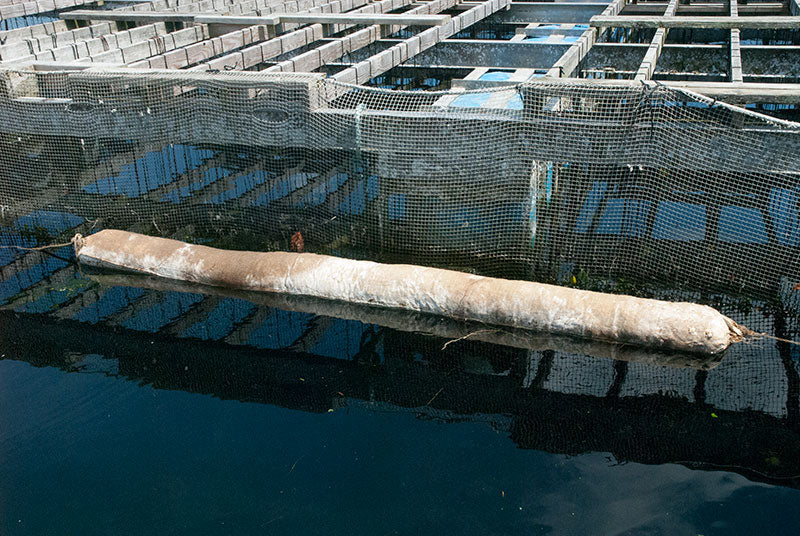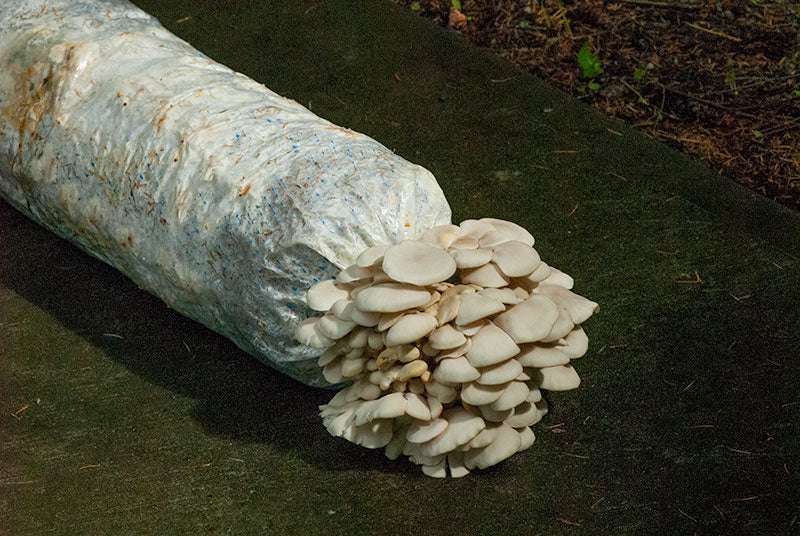
The Petroleum Problem
Thank you for visiting fungi.com, and for your interest in the BP oil spill disaster and the potential for mycoremediation.
We are being inundated with requests and cannot individually address all of the questions we have received. We are in direct dialogue with the EPA at the highest levels, and are teaming to implement solutions to this huge disaster. Since we are such a small company, we are stretched to our limits. Your support allows us to dedicate as many of our resources as possible, and for this we thank you. Again, please accept our apologies if we cannot individually address your concerns. Our statement at below will be updated periodically as we gather more information.
Most of you have my latest book, Mycelium Running: How Mushrooms Can Help Save the World, which describes methods for mycoremediation. For those of you who do not, we recommend you read the chapters on mycoremediation as a first step in better understanding how fungi can decompose toxic substances and lead the way to habitat recovery.
On this planet together,
Cheers to you, Tears for the Earth,
Paul Stamets and the Fungi Perfecti Team
PAUL STAMETS’ STATEMENT ON MYCOREMEDIATION
AND ITS APPLICATIONS TO OIL SPILLS
The BP oil spill has inflicted enormous harm in the Gulf of Mexico and will continue to do so for months, if not decades, to come. I have many thoughts on this disaster. My first reaction is that when the skin of the Earth is punctured, bad things can happen.
Clearly, this disaster could and should have been prevented. Despite all their assurances of safety, BP and/or BP’s subcontractors, failed to ensure the functionality of the emergency equipment on the Deep Horizon rig. The oil industry claims that further regulation will handcuff them, but it is now obvious that more steps need to be taken to prevent a catastrophe like this from ever happening again.
However, this spill did happen, and we now must deal with the aftermath. Although estimates have been that BP could be liable for more than 14 billion dollars in clean up damages, very few in the media have mentioned the long-term, generational consequences of this oil spill. There will inevitably be a surge in cancer cases, widespread degradation of wildlife habitat, and an array of diverse and complex strains on local communities, our nation, and the planetary ecosphere as a whole. We all know that the seas are connected, and ultimately our biosphere suffers globally when suffering locally. Now as the hurricane season approaches, we may see catastrophes converge to create what may be the greatest ecological disaster in hundreds of years.
While we will need a wide array of efforts to address this complex problem, mycoremediation is a valuable component in our toolset of solutions. Mycoremediation has demonstrated positive results, verified by scientists in many countries. However, there is more oil spilled than there is currently mycelium available. Much more mycelium is needed and, fortunately, we know how to generate it.
Here is what we know about mycoremediation, based on tests conducted by myself, my colleagues and other researchers who have published their results. (See attached references.)

Oil being absorbed by mushroom mycelium
What we know:
1) [Update] We now know that one of our strains of Oyster mushrooms (Pleurotus ostreatus) is tolerant to saltwater exposure. The mycelium fully colonizes salt water soaked straw. Our tests with MycoBooms™ (see below) are being conducted in the waters of the Puget Sound, the average salinity of which is approximately 3.3%, only .2% less than the average salinity of the world's oceans.
2) Straw that has been inoculated with Oyster mushroom mycelium floats, making it a potential candidate for use in water-borne mycelial containment/filtration systems.
3) More than 120 novel enzymes have been identified from mushroom-forming fungi.
4) Various enzymes breakdown a wide assortment of hydrocarbon-based toxic substances.
5) My work with Battelle Laboratories, in collaboration with their scientists, resulted in TAH’s (Total Aromatic Hydrocarbons) in diesel contaminated soil to be reduced from 10,000 ppm to < 200 ppm in 16 weeks from a 25% inoculation rate of oyster (Pleurotus ostreatus) mycelium, allowing the remediated soil to be approved for use as landscaping soil along highways. (Thomas et al., 1999; Thomas, 2000)
6) Oil contains a wide variety of toxic substances, many of which are carcinogens.
7) Mycelium more readily degrades lower molecular weight hydrocarbons (3,4,5 ring) than heavier weight hydrocarbons. However, the heavier weight hydrocarbons are reduced via mycelial enzymes into lighter weight hydrocarbons, allowing for a staged reduction with subsequent mycelial treatments.
8) Aged mycelium from oyster mushrooms (Pleurotus ostreatus) mixed in with ‘compost’ made from woodchips and yard waste (50:50 by volume) resulted in far better degradation of hydrocarbons than oyster mushroom mycelium or compost alone.
9) Oyster mycelium does not degrade keratin-based hair as it produces little or no keratinases, whereas other mold fungi such as Chaetomium species (which include some high temperature-tolerant leaf mold fungi) produce keratinases.
10) Worms die when put into contact with high concentrations of hydrocarbon saturated soils, but live after mycelial treatments reduce the toxic substances below the lethal thresholds.
11) Spring inoculations work better than fall inoculations as the mycelium has more time to grow-out. Bioregional specificities must be carefully considered.
12) Amplifying native mushroom species in the bioregion impacted by toxic spills work better than non-native species.
13) More funding is needed to better understand and implement mycoremediation technologies.
14) Oil spills will occur in the future—we need to be ready for them!

Oyster mushrooms producing on oil contaminated soil (1–2% = 10,000–20,000 ppm). We do not recommend eating food crops from contaminated soils. Photo credit: Susan Thomas.

Soil toxicity reduced in 16 weeks to less than ~ 200 ppm, allowing for plants, worms and other species to inhabit whereas control piles remained toxic to plants and worms. Photo credit: Susan Thomas.
What we don’t know:
1) The differential gradients of decomposition of the complex oil constituents from contact with Oyster mushroom mycelium. Different toxic substances degrade at different rates when placed into contact with mycelium.
2) The variables that influence the success of mycoremediation, particularly since the targeted toxic substances are often complex mixtures of volatile and non-volatile hydrocarbons.
3) How many other species of fungi could be applied for mycoremediation beyond the few that have been tested? Up to now, Oyster mushroom mycelium (Pleurotus ostreatus) has been tested successfully but there are literally thousands of other species yet to be tested for mycoremediation.
4) How each fungal species used pre-selects the subsequent biological populations and how these further enable plant communities as habitats recover from toxic waste exposure?
5) Whether or not the mushrooms grown on decomposing toxic wastes are safe to eat.
6) To what degree of decomposition by mycelium of toxic soils makes the soils safe for food crops.
7) How economically practical will it be to remove mushrooms that have hyper-accumulated heavy metals—will this be a viable remediation strategy? Which species are best for hyper accumulating specific metals?
8) How to finance/design composting centers around population centers near pollution threats.
9) How to train—on a massive scale—the mycotechnicians needed to implement mycoremediation.
10) How to fund ”Myco-U’s”, learning centers with emphasis on implementing myco-solutions to human made and natural catastrophes.
11) How extensively and diversely will mycoremediation practices be needed in the future?

Pouring crank case oil onto oyster mushroom compost after it has produced several crops of mushrooms

New crop of mushrooms form several weeks later. The spores released by these mushrooms have the potential—as a epigenetic response—to pre-select new strains more adaptive to this oil-saturated substrate.
How can we help?
Knowing that the extent of this disaster eclipses our mycological resources should not be a reason to not act.
I proposed in 1994 that we have Mycological Response Teams (MRTs) in place to react to catastrophic events, from hurricanes to oil spills. We need to preposition composting and mycoremediation centers adjacent to population centers. We should set MRTs into motion, centralized in communities, which are actively involved in recycling, composting and permaculture—utilizing debris from natural or man-made calamities to generate enzymes and rebuild healthy local soils.
I see the urgent need to set up webinar-like, Internet-based modules of education to disseminate methods for mycoremediation training so people throughout the world can benefit from the knowledge we have gained through the past decade of research. Such hubs of learning could cross-educate others and build a body of knowledge that would be further perfected over time, benefiting from the successes and failures of those in different bioregions. The cumulative knowledge gained from a centralized data hub could emerge as a robust yet flexible platform that could help generations to come. Scientists, policy makers, and citizens would be empowered with practical mycoremediation tools for addressing environmental disasters.
There are additional opportunities here. By encouraging strategically placed gourmet mushroom production centers near debris fields from natural and human-made disasters, we can open a pathway for mycoremediation. The ‘aged compost’ that is produced after mushrooms are harvested is rich in enzymes—a value-added by-product and this ‘waste’ product is aptly suited for mycoremediation purposes. What most people do not realize is that most mushroom farms generate this compost by the tons and are eager for it to be used elsewhere.
The scope and continuing magnitude of the Deepwater Horizon/BP oil spill is unprecedented, and calls for unprecedented responses. Time to 'think outside the box'. Here is, perhaps, one path to a solution in response to the BP oil spill disaster. This is experimental and not yet proven, but I think this approach merits serious testing, and may be especially applicable inside of the containment booms, and along marshlands.
We are currently testing "MycoBooms™"; straw colonized with oyster mushroom (Pleurotus ostreatus) mycelium encased in hemp-tubes.

Mycoboom™ floating in saltwater in Totten Inlet, southern Puget Sound near Kamilche Point, Washington.


Progression of oil absorbtion of Oyster mycelium on straw floating in oily water over a three day period. Note absorption of oil into above water line and emergence of clear patch of water.
Among the potential advantages of the MycoBooms are these:
1) Straw colonized with Oyster mushroom mycelium floats, making MycoBooms potentially suitable for both oil absorbtion/remediation and for corraling and containing oil slicks. Moreover, myceliated straw and woodchips could be broadcasted between the shoreline and the containment booms to create a floating debris field to capture and degrade hydrocarbons.
2) Mycelium and straw both absorb oil.
3) Oyster mushroom mycelium emits enzymes that can break down oil continuously for weeks, if not months, thus starting the decomposition of oil process, reducing the complex hydrocarbons into simpler, more unstable forms.
4) Oyster mushroom mycelium supports non-pathogenic bacterial communities as they age, which in turn can break down oil in their own way.
5) MycoBooms in hemp socks are fully biodegradable.
6) As mycelium outgasses and mushrooms form, fungus gnats and flies are attracted, and fish, bird, bat and insect populations may further benefit from an emerging food resource.

Oyster mushroom fruiting from the end of a MycoBoom™
On a grand scale, I envision that we, as a people, develop a common myco-ecology of consciousness and address these common goals through the use of mycelium. To do so means we need to spread awareness and information. Please spread the word of mycelium. Educate friends, family and policy makers about mycological solutions. Bring your local leaders up the learning curve on how fungi can decompose toxic substances, rebuild soils and strengthen our food chains. What we lack is the widespread availability of mycologically skilled technicians and educators and a more mycologically informed public. We need a paradigm shift, a multi-generational educational infrastructure, bringing fungal solutions to the forefront of viable options to mitigate disasters. An unfortunate circumstance we face is that the field of mycology is poorly funded in a time of intense need.
To support this expanded mycological awareness, I offer my books as resources—especially Mycelium Running: How Mushrooms Can Help Save the World and Growing Gourmet and Medicinal Mushrooms. Also, please see my talk on Ted.com—this is an excellent primer for those wanting to understand how mushrooms and fungi can help mitigate disasters and heal ecosystems.
Let's become part of the solution. We may not have all the answers now but we can work towards an integrated strategy, flexible in its design, and yet target specific to these types of disasters. We should work in preparation to resolve ecological emergencies before and after they occur. Together, we can protect and heal our communities and ecosystems.
For the Earth,
THE PROBLEM: OIL IS A COMPLEX MIXTURE OF TOXIC HYDROCARBONS
Not many people, even experts, fully grasp the diverse range of toxic substances that are present in oil. Bunker C oil is used as a fuel, particularly in cargo ships, and is especially ‘dirty’. Here is a list of some of the hydrocarbons typically found in Bunker C oil:
| CONTAMINANTS IN BUNKER C OIL | ||
| cis/trans-Decalin C1-Decalins C2-Decalins C3-Decalins C4-Decalins Benzothiophene C1-Benzo(b)thiophenes C2-Benzo(b)thiophenes C3-Benzo(b)thiophenes C4-Benzo(b)thiophenes Naphthalene C1-Naphthalenes C2-Naphthalenes C3-Naphthalenes C4-Naphthalene Biphenyl Dibenzofuran Acenaphthylene Acenaphthene Fluorene C1-Fluorenes C2-Fluorenes C3-Fluorenes Anthracene Phenanthrene C1-Phenanthrenes/Anthracenes C2-Phenanthrenes/Anthracenes C3-Phenanthrenes/Anthracenes C4-Phenanthrenes/Anthracenes Retene Dibenzothiophene C1-Dibenzothiophenes C2-Dibenzothiophenes C3-Dibenzothiophenes C4-Dibenzothiophenes Benzo(b)fluorene Fluoranthene Pyrene C1-Fluoranthenes/Pyrenes C2-Fluoranthenes/Pyrenes |
C3-Fluoranthenes/Pyrenes C4-Fluoranthenes/Pyrenes Naphthobenzothiophenes C1-Naphthobenzothiophenes C2-Naphthobenzothiophenes C3-Naphthobenzothiophenes C4-Naphthobenzothiophenes Benz[a]anthracene Chrysene/Triphenylene C1-Chrysenes C2-Chrysenes C3-Chrysenes C4-Chrysenes Benzo[b]fluoranthene Benzo[k]fluoranthene Benzo[a]fluoranthene Benzo[e]pyrene Benzo[a]pyrene Perylene Indeno[1,2,3-cd]pyrene Dibenz[a,h]anthracene Benzo[g,h,i]perylene C23 Tricyclic Terpane (T4) C24 Tricyclic Terpane (T5) C25 Tricyclic Terpane (T6) C24 Tetracyclic Terpane (T6a) C26 Tricyclic Terpane-22S (T6b) C26 Tricyclic Terpane-22R (T6c) C28 Tricyclic Terpane-22S (T7) C28 Tricyclic Terpane-22R (T8) C29 Tricyclic Terpane-22S (T9) C29 Tricyclic Terpane-22R (T10) 18a-22,29,30-Trisnorneohopane-TS (T11) C30 Tricyclic Terpane-22S (T11b) C30 Tricyclic Terpane-22R 17a(H)-22,29,30-Trisnorhopane-TM (T12) 17a/b,21b/a 28,30-Bisnorhopane (T14a) C30 Tricyclic Terpane-22R |
17a(H)-22,29,30-Trisnorhopane-TM (T12) 17a/b,21b/a 28,30-Bisnorhopane (T14a) 17a(H)-22,29,30-Trisnorhopane-TM (T12) 17a(H),21b(H)-25-Norhopane (T14b) 30-Norhopane (T15) 18a(H)-30-Norneohopane-C29Ts (T16) 17a(H)-Diahopane (X) 30-Normoretane (T17) 18a(H)&18b(H)-Oleananes (T18) Hopane (T19) Moretane (T20) 30-Homohopane-22S (T21) 30-Homohopane-22R (T22) 30,31-Bishomohopane-22S (T26) 30,31-Bishomohopane-22R (T27) 30,31-Trishomohopane-22S (T30) 30,31-Trishomohopane-22R (T31) Tetrakishomohopane-22S (T32) Tetrakishomohopane-22R (T33) Pentakishomohopane-22S (T34) Pentakishomohopane-22R (T35) 13b(H),17a(H)-20S-Diacholestane (S4) 13b(H),17a(H)-20R-Diacholestane (S5) 13b,17a-20S-Methyldiacholestane (S8) 14a(H),17a(H)-20S-Cholestane (S12) 14a(H),17a(H)-20R-Cholestane (S17) 13b,17a-20R-Ethyldiacholestane (S18) 13a,17b-20S-Ethyldiacholestane (S19) 14a,17a-20S-Methylcholestane (S20) 14a,17a-20R-Methylcholestane (S24) 14a(H),17a(H)-20S-Ethylcholestane (S25) 14a(H),17a(H)-20R-Ethylcholestane (S28) 14b(H),17b(H)-20R-Cholestane (S14) 14b(H),17b(H)-20S-Cholestane (S15) 14b,17b-20R-Methylcholestane (S22) 14b,17b-20S-Methylcholestane (S23) |
TOWARDS AN INTEGRATED SOLUTION: MYCOREMEDIATION RESOURCES
Recommended texts:
Gadd, G. 2001. Fungi in Bioremediation. Cambridge University Press.
Singh, H. 2006. Mycoremediation: Fungal Bioremediation. Wiley Interscience.
Stamets, P. 2005. Mycelium Running: How Mushrooms Can Help Save the World. Ten Speed Press, Berkeley, California.
Recommended articles:
S. Thomas, P. Becker, M.R. Pinza , J.Q. Word, 1999. “Mycoremediation of Aged Petroleum Hydrocarbon Contaminants in Soil.” NASA no. 19990031874.
S. Thomas, 2000. Personal Communication. "Subsequently to the end of the study, WSDOT retested the soils at its own expense, with a more detailed sampling regime, and found that it did indeed meet the EPA criterion of less than or equal to 200 ppm TPH, which allowed WSDOT to use the soil in highway landscaping." Nov. 30. Email to Paul Stamets.
V. Šašek, John A. Glaser, Philippe Baveye, 2000. “The Utilization of Bioremediation to Reduce Soil Contamination: Problems and Solutions.” Nato Science Series IV. Earth and Environmental Sciences vol. 19.
M. Bhatt, T. Cajthaml and V. Šašek, 2001. “Mycoremediation of PAH-contaminated soils.” Folia Microbiologica, Springer Netherlands,Volume 47, Number 3 / June, 2002.
Eggen, T., and V. Sasek. 2002. "Use of edible and medicinal oyster mushroom [Pleurotus ostreatus (Jacq.:Fr.) Kimm.] spent compost in remediation of chemically polluted soils." International Journal of Medicinal Mushrooms 4: 225–261.
T. Cajthaml, M. Bhatt, V. Šašek, and V. Mateju. 2002. "Bioremediation of PAH-contaminated soil by composting: A Case Study." Folia Microbiologica 47(6): 696–700.
T. Cajthaml, M. Moder, P. Kacer, V. Šašek, and P. Popp. 2002. "Study of fungal degradation products of polycyclic aromatic hydrocarbons using gas chromatography with ion trap mass spectrometry detection." Journal of Chromatography A, 974: 213–222.
V. Šašek, 2003. “Why mycoremediations have not yet come into practice” The Utilization of Bioremediation to Reduce Soil Contamination: Problems and Solutions, 247-266. Kluwer Academic Publishers, Netherlands.
Giubilei, Maria A; Leonardi, Vanessa; Federici, Ermanno; Covino, Stefano; Šašek, Vaclav; Novotny, Cenek; Federici, Federico; D'Annibale, Alessandro; Petruccioli, Maurizio, 2009, June. “Effect of mobilizing agents on mycoremediation and impact on the indigenous microbiota.” Journal of Chemical Technology & Biotechnology, Volume 84, Number 6, June 2009, pp. 836–844(9). John Wiley & Sons, Ltd.
